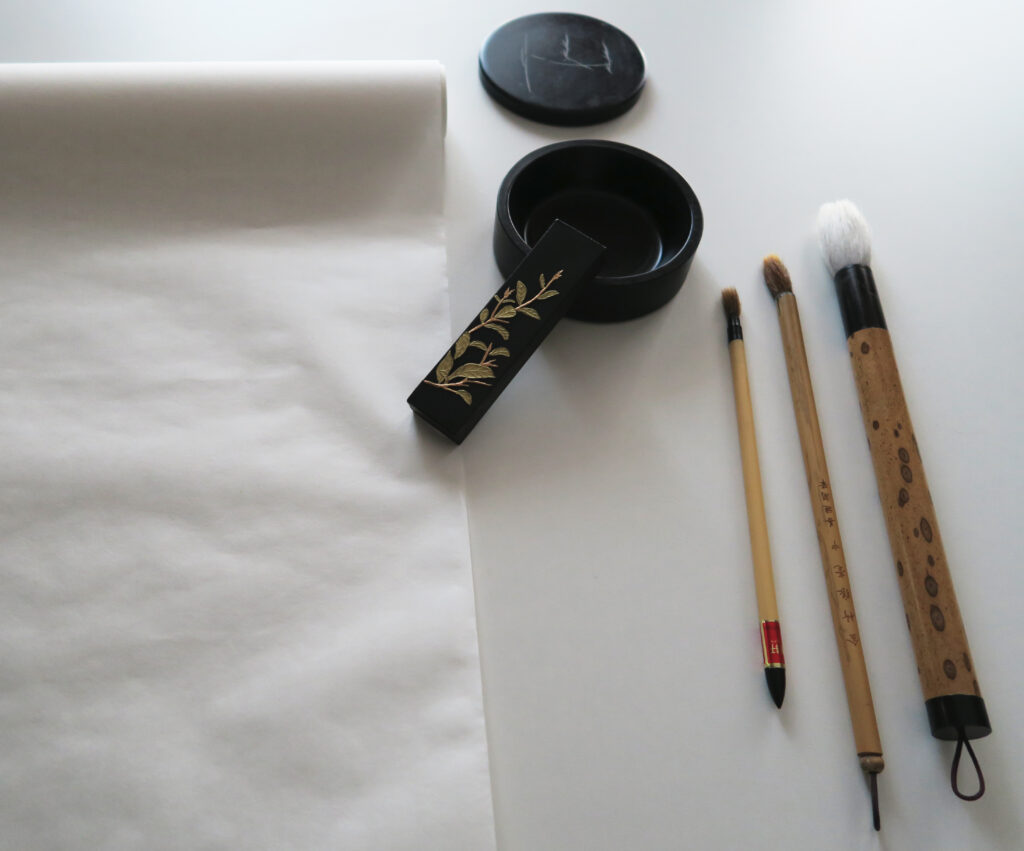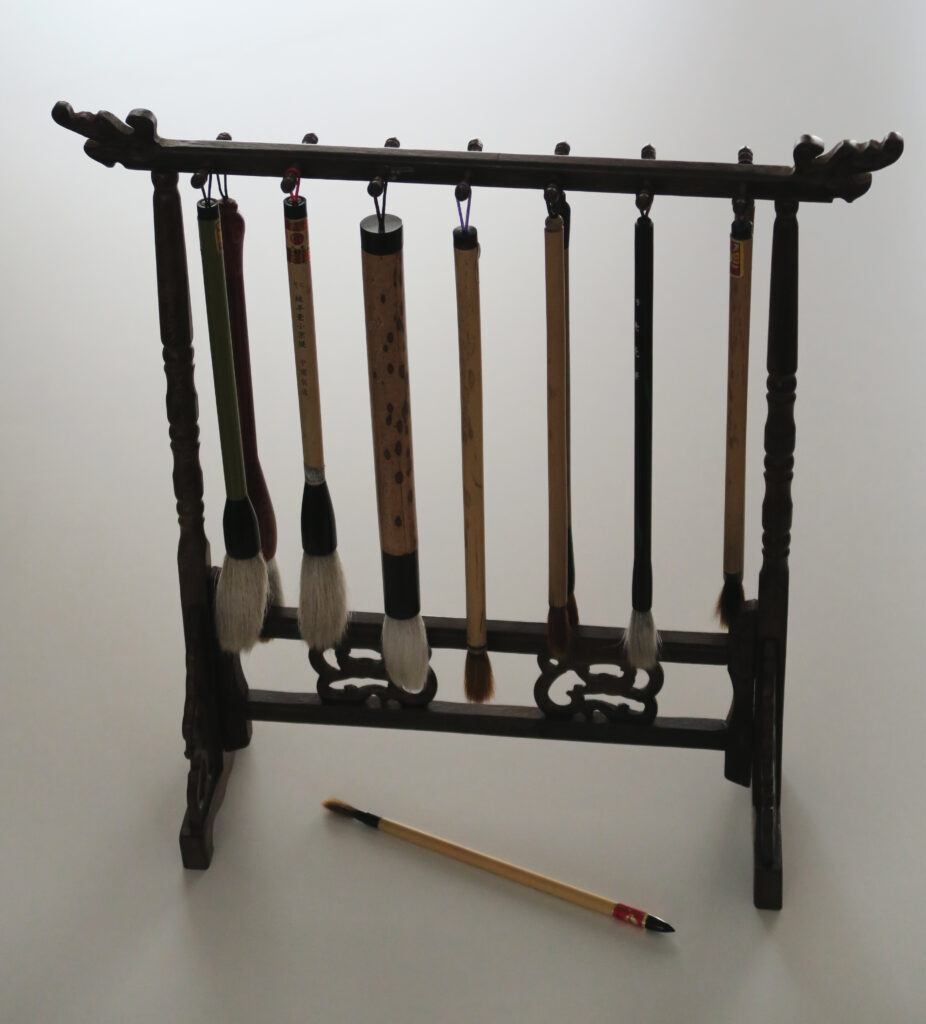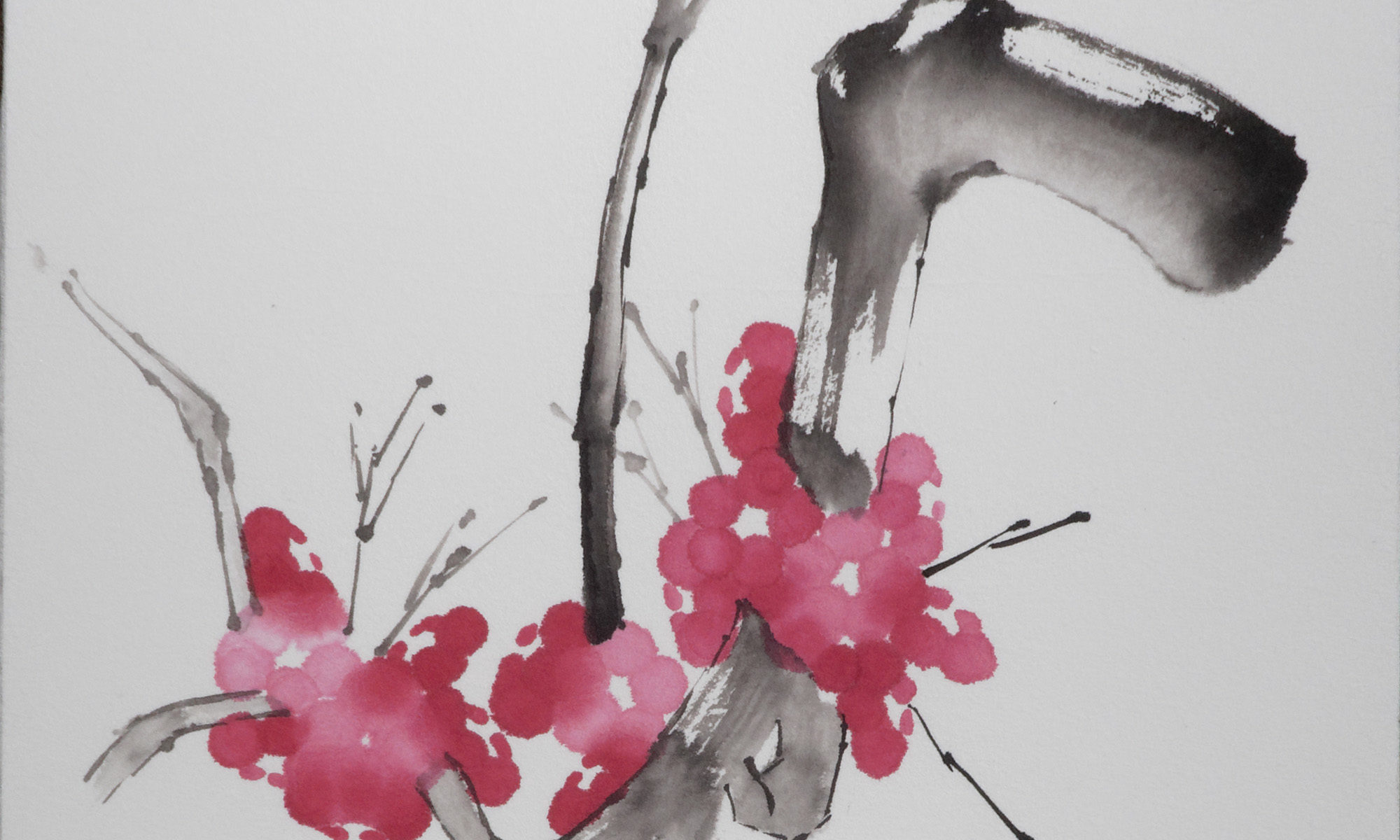This post is also available in:
Français
Presentation
“From a Chinese origin, this method of China ink painting called sumi-e was introduced in Japan by Zen monks more than five centuries ago. With a simple brush, an ink bar, an inkstone and rice paper, we focus our attention on the present moment. We let go of our thoughts, we eliminate the tensions of the body, thanks to a good posture and a correct breathing. This way of painting can unveil the creativity of who is practicing it, making him/her more sensitive, more attentive and more harmonious in the acceptance of oneself, of others as well as of one’s own difficulties; also putting in touch with the source of life that resides in oneself. Students work together in harmony and concentration, in a calm and quiet atmosphere. There is no competition for a result; it is a work of patience that aims to refine the sensitivity of each, to reach a defined characteristic of its own expressive mode and the fluidity of the gesture, as if producing a flower, a rock, a bamboo emanated almost naturally from our own body.”
After Beppe Mokuza Signoritti
For an in-depth presentation, see below Beppe Mokuza Signoritti’s conference on sumi-e
Painter’s tools

Ink is the medium that reveals the essence of the subject, manifests it.
It is deposited by the brushes, which are very similar to those used in calligraphy.
It is absorbed by the paper. The paper is called “rice paper”, but it is usually a mulberry paper, which also gives the “silk paper”, but here soft, fine and resistant.

The painting is done in shades of gray, by diluting more or less the black Indian ink with water, both to represent the values of light and to give an impression of depth, the distance fades in the clear values.
The Sumi-e, by Beppe Mokuza Signoritti
Quotes come from the book “Vide et Plein” by François Cheng.
The philosophical basis of sumi-e
To introduce Chinese ink painting (sumi-e), it is necessary to briefly mention the importance of painting in China, since it is in this cultural, philosophical and artistic context that monochrome painting was born.
Of all the arts in China, painting occupies the supreme place and in the eyes of a Chinese, it is indeed the pictorial art that reveals par excellence the mystery of the universe. At its base is a fundamental philosophy, Taoism, which proposes precise conceptions of cosmology, human destiny and the relationship between man and the universe.
Painting, being the application of this philosophy, penetrates the mysteries of the universe. Rather than describing the “spectacles of Nature”, it seems to take part in its own “gestures”. It is rather a particular way of living, a mediumistic place where is possible the real life but also the coincidence between art and art of living. The sublime work of art tries to realize a vital microcosm that reflects the macrocosm and is called sublime because it is linked to Life, to the original Spirit.
In this regard, an old adage states that “those who have ‘bathed’ in painting will live longer, because the life created by the touch of the brush strengthens life itself”: indeed, in the tradition of ancient China, the harmony of an artistic work reflects the universal harmony of the Tao, the supreme and unfathomable principle that created the world and governs the secret rhythm of nature.
It is no coincidence that the dominant theme of great Chinese painting is the landscape, a landscape that is always subtly realistic and at the same time metaphorical.
The human figures and the works of man never distract the eye from the central elements of the painting, a mountain, a waterfall, a tree, a bamboo or an orchid. On the contrary, their arrangement establishes a climate of symbolic correspondences and, by analogy, refers to the balances established by the Tao between Heaven and Earth, man and nature, heaviness and lightness, emptiness and fullness. In each thing, whether it is a living entity or a human art, circulates the Ch’i (in Japanese Ki), a spirit, a breath, an impalpable force: the ideogram Tao (Do) means “the Way”, and a way is made only to be very concretely borrowed and traveled.
These same principles are embodied by the painter who, through the art of the brush, moves himself towards Life and allows Life to manifest itself through his works since “the pressure of the brush should conform to the conception that dwells in the heart” and “the one who learns to paint must first learn to calm the heart, and thus make his own understanding clearer… He must feel certain that he is learning what he has been prepared for and that in him the heart and the hand are in perfect harmony.
Still in the famous adage of Chang Tsao of the T’ang, it is written:
In the outer world, take the Creation as your model,
in the inner world, follow the source of the soul.
Main themes
Painting, par excellence, reflects the history of the Chinese soul, because the painter in China was not only a professional artist, but also a philosopher, a sage. For this reason, the Chinese considered painting as “the perfection of knowledge”, the scholarly expression of the cultural level and moral integrity of a painter.
The main themes of traditional Chinese painting are four in number and, in essence, remain unchanged in Japanese painting: landscapes, portraits, birds and animals, flowers and plants. In painting, nature often assumes a symbolic meaning as we have just said.
Bamboo, for example, embodies eternal friendship and longevity. It represents flexibility rooted in strength. Moreover, it requires an inner behavior of great flexibility which makes man strong since, like the bamboo, in front of the events of life, he does not oppose the change but on the contrary follows it and adapts to it.
Man, like bamboo, is “green in all seasons”, which means remaining intimate and balanced even through the passing seasons and phases of life.
Orchid, bamboo, plum, and chrysanthemum represent the KI or life energy of the four seasons and the four periods of a man’s life, and are considered the “four nobles.
But we will take up later this presentation of the subjects to be studied in particular in sumi-e, which represent true models to imitate or if you prefer to copy, to learn the technique and all the infinite variety of the forms of nature.
Historical references: introduction and diffusion of sumi-e in Japan
Having said that, I would like to point out that it was during the Kamakura period (1192-1333), or the period when power shifted from the hands of the nobility to the hands of the warriors (samurai), that the pilgrimages of Zen monks to China and the commercial contacts with the latter determined the arrival in Japan of numerous Chinese paintings and manufactured products which exerted a determining influence on the artists in the service of the temples to whom works were commissioned by patrons and collectors (shogun).
These imports not only inspired an evolution of the subjects of painting, but opened the way to an innovative use of colors: the tints of Yamato-e (painting on long scrolls, (9th and 10th centuries) gave way to the monochrome tones of the Chinese technique.
Derived from the work of the great Ch’an (Zen Buddhism) masters and painters of the Tang and Sung periods, Chinese ink painting was characterized in Japan by the spread of Suiboku-ga or Sumi-e (late 13th century).
Initially, it became almost the exclusive monopoly of Zen Buddhism and was adopted by monks and artists imbued with its spirit, so that for a long time, black ink painting (sumi-e) and Zen painting (Zenga) were practically inseparable.
The greatest sumi-e master of this period was Sesshu (1420-1507), a Zen monk from Kyoto, who studied ink painting in China with the monk Shubun. He was the only one to assimilate the philosophical basis of this kind of painting, translating it in an original way into Japanese themes and artistic language, even with regard to the spatial research of Chinese artists.
The art of painting of these monks was identified with the very practice of Zen. To understand its particularity, it is necessary to know and take into account the philosophical basis of Zen, its practice based on the concept of Emptiness, as the original nature of man.
A practice based on the Void
To express the inexpressible, to communicate the incommunicable: was it not perhaps the apparently paradoxical intention of Shakyamuni the Buddha when, having gathered all his disciples on the Mount of the Vulture, at their request to pronounce a discourse on the Law (the Eternal), he did nothing more than hold up a flower and, remaining in perfect silence, turned it between his fingers?
If this was really Shakyamuni’s intention, we can guess why, according to the famous story, not one of the many people present managed to grasp the deep meaning of the Master’s gesture: like any other thing or event in the universe, this meant and could mean absolutely nothing and therefore meant everything.
No one was able to understand and no one spoke: only Maha Kashyapa, meeting the Buddha’s gaze, had the limpid revelation of this immense Nothing and smiled in the corner; and, for this wordless smile, he was considered the depositary of the unique message of the Enlightened One and of all his teaching.
This is the ancient heart of Zen. It is the authentic and immediate expression of the supreme experience of enlightenment: that is, of that dazzling vision (satori) of the true nature of things, “the Void”, capable of awakening us from the great sleep of suffering and anguish of human existence. Of this ineffable existence, which leads to nirvana (the true wisdom where painful states of consciousness cease), Zen proclaimed the direct transmission of “heart to heart” without depending on words but looking into one’s own nature, according to the teaching of its legendary founder, Bodhidharma, and in the sincere conviction that “if you don’t find it in yourself, where will you go to look for it?”
What we consider today to be authentic pictorial creations of great value are in reality only suggestive “direct indications” of that inexpressible nature of the Void, which was the discovery of the Buddha and illuminated the face of his best disciple.
The Way of the Brush
Zen painting (especially the more recent ones from the seventeenth to the nineteenth century) is different from what we commonly understand by painting: in reality, Zen paintings are a kind of “sketch” in black and white, where the white (the paper) represents the universe itself, and the black (the Indian ink) the material forms that appear and disappear in the universe. To visually express the vital essence of these forms and the eternal meaning they conceal is the duty of the true Zen painting master.
Like the tea ceremony called “Way of Tea”, painting is also considered a Way (Do). It is the practice of a traditional method which corresponds to an effective learning of the conscience. Handling the brush with supreme skill, the consciousness practices to surpass itself and its personal egotic limits, thus harmoniously attuning itself to the unconscious in the state of “non-consciousness of self”.
Shen Tsung Ch’ien said:
the play of the Brush must be dominated by the breath.
When the breath is, the vital energy is;
it is then that the Brush truly generates the Divine.
If, however, the correct practice of a Way requires the learning of all the knowledge that is the basis of it, the technique alone is not enough to achieve a Zen style creation: the artist must forget himself and all that he has learned, to let himself go at the mercy of inspiration and become one with the perfection of the personal technical skill.
At that moment, “mind and body disappear”, the person becomes one with the Being that is in him, and the work of art arises by itself, freely and spontaneously, without depending on the personal will of the author: he limits himself to naturally assisting the process of creation without making any intentional effort.
Let’s see for example what happens when you want to paint a bamboo with the sumi-e technique: you sit down (but you can also stand), keeping your back straight, you put a sheet of paper in front of you and you concentrate on it, breathing calmly, naturally. We let all other thoughts dissipate. At the end, there remains only a white sheet in our head. Then we let the image to be painted present itself to our mind. To paint a bamboo, we must feel its “consistency”, see the trunk, the branches, hear the rustle of the light leaves animated by the air or the wind, or wet, weighed down by the rain.
Our whole mind becomes impregnated with it and in a way, we become the bamboo, it is indescribable. We then take the brush and let our hand go, naturally and without effort. We don’t think about the technique or the result, there is no conscious effort to make a good painting. Our complete bamboo will take shape little by little and we will have an undeniably lively painting. The bamboo is created “from scratch”, it is not purely copied.
Moreover, on the rice paper, only one brushstroke is allowed for each line; each retouch is immediately perceived. Any mental path that complicates the drawing (and life) is abandoned. We understand that thoughts about life are not really life itself. Thoughts about Zen are not Zen, they are just thoughts.
Master Sung Tung Po writes:
Before painting a bamboo, it must grow inside you.
It is then that the brush in hand, the concentrated look, a vision arises in front of you.
Seize it immediately with the brush strokes, because it can disappear as suddenly as the hare at the approach of the hunter!
The authentic sumi-e
To return to the Japanese term, “sumi” means black ink, “e” means paint. As we have already said, the subjects are painted with black ink, in shades varying from pure black to all the shades that can be obtained by diluting it with water. This does not mean that everything painted in this way can be called sumi-e.
True sumi-e must have certain typical characteristics, such as sobriety and spontaneity, which directly affect the viewer’s sensitivity. For a painting to be alive, all its components must be alive. This type of painting already includes the drawing, no preparatory lines are necessary, unlike traditional painting, every superfluous form or detail is neglected.
The sumi-e collects the essence of nature, that is to say that it is in tune with this “rhythmic movement of the Spirit” which is present in everything and which the artist brings back to life in the figurative image.
This way of painting, introduced in Japan by Zen monks, was a rapid success because in this pictorial technique, as in the practice of Zen, the expression of reality is reduced to its pure, essential form. The retouching, the additions, the decorations in reality do not embellish a work, but only veil its natural truth, its true nature. It’s a bit like cooking: if you put too many condiments and too many spices, you won’t really feel the taste of what you are cooking.
And just as in Zen, where few words are enough to express the meaning of so many hours of meditation, in Sumi-e few brushstrokes on a single sheet of white paper can represent the most complex pattern. One must learn to gather the essence, the truth as it is.
Learning
This way of painting is complete, it involves the whole body. It is by no means easy, and a master is indispensable, as well as getting used to repeating the subjects or details of them many times. The mind becomes more and more refined and sensitive through constant repetition.
It is inevitable that at the beginning our paintings are cold and lack spontaneity. One should then want more beauty in one’s own work, but this should not turn into an obsession of wanting to be a perfect sumi-e practitioner because then one will not make any progress. If one continues to think in terms of good or bad, one is still distant from the true spirit of sumi-e.
As in Zen, the mind must be free of any voluntary desire for success or ambition. Thus, probably before you know it, you will feel able to paint anything you wish because every element of a landscape will appear to be the very reflection of original life and nature. You will also find that you breathe better, that your gait is straighter and nobler, that even the general state of health, including mental balance, has improved.
Like Zen, Zazen is not the pure learning of a meditation technique, but it is the direct contact with the origin of everything (“Buddha nature”). Thus sumi-e goes far beyond a simple painting technique.
